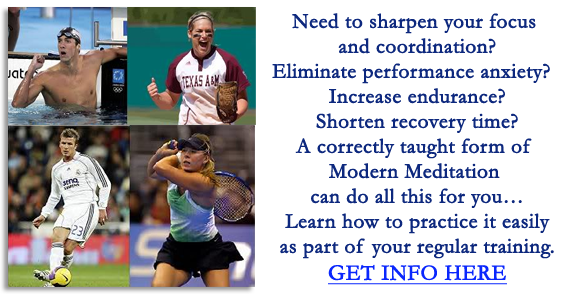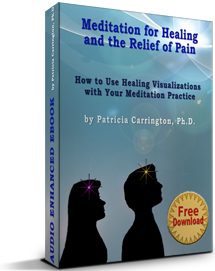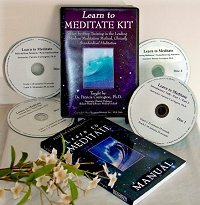Meditating Under Special Circumstances
Enhancing Athletic Performance
Patricia Carrington, Ph.D.
Author of “The Book of Meditation”
Probably the most widely publicized use of meditation for strategic purposes has been for athletics. A number of athletes report that they use meditation to prepare for athletic contests. It seems worth investigating what elements of meditation make it particularly useful for people engaged in sports.
Meditation, as we have seen, tends to reduce anxiety levels, making the meditator calmer, less worried and more quietly self-confident – obviously useful attributes for an athlete who is about to enter a contest. Relaxation and ease of mind can be helpful in almost any undertaking, but in sports it is important that the person not be so relaxed that he stops caring whether or not he wins the contest, a point which will be discussed later in this article.
A student of mine at Princeton, Andy Rimol, became interested in this subject. Captain of the university’s basketball team, he claimed that meditating had greatly improved his game. According to his report, after he started meditating with TM in his sophomore year, his stamina increased markedly and he was easily able to undertake extra sessions in basketball on the same day without feeling fatigue. He also reported that his coordination in the game improved.
Because he was so personally impressed by the effects of meditation on his athletic prowess, Rimol decided to conduct a research study in our laboratory to measure the perceptual motor hand–eye coordination of meditators and non-meditators by comparing their performances. He also planned to compare two different groups of meditators, those who would be allowed to meditate just before the perceptual-motor task and those who would not.
Blasdall’s Star Tracers
Before Rimol commenced his study, however, another researcher, Blasdall, had compared the performance of regular TM meditators with that of non-meditators on the Mirror Star Tracing Task, a rather difficult and sometimes quite frustrating puzzle-like test where the subject is handed a pencil and asked to trace a design of a star by looking at it in the mirror only.1 This means, in effect, making your hand move backward, mirror-image fashion. Before being asked to perform this task, the meditators meditated for twenty minutes while the non-meditators simply rested for twenty minutes with their eyes closed. This way both groups were in a rested state when they undertook the Star Tracing Task. As the experimenter had predicted, the meditators performed significantly better in this task than the non-meditators.
Although this was certainly a promising start, Blasdall’s study had left open certain questions. For example, how do we know that the meditators would not have done better than the non-meditators in the Star Tracing Task if they had just walked into the experimental laboratory ‘cold’, without being allowed to meditate first? In other words, maybe it is possible that people who have been meditating for a long time simply have better coordination – perhaps the immediate meditation before the task had absolutely nothing to do with Blasdall’s results. Obviously this question is important when considering the value of a strategic use of meditation for athletics.
Rimol’s Labyrinth Players
Rimol reasoned that meditation might have both long-term and immediate effects on perceptual-motor performances.2 Based on his own experiences and those of other athletes whom he knew, he felt that regular meditation did improve coordination skills in general, but his own experience had taught him that meditating prior to an important basketball game also helped him do better in that specific game than if he had neglected to meditate beforehand. The challenge was to design an experiment which would test both these possibilities at once.
He chose three groups of male college students as the subjects in his experiment. The first two groups included students who had been practicing TM regularly for five months or more before the study started. The third group had never practiced TM or any other kind of meditation.
To measure the subjects’ motor skills, Rimol chose to use a rather demanding game – the ‘labyrinth game’. It consists of a movable board fastened in place in a box. Two controlling band dials on either side of the box can manipulate the board so it tilts forward, backward, or toward either side, and the player is allowed to use both bands at once to tilt the board. The board has a numbered path with sixty holes scattered along it, the goal of the game being to get a round metal ball from the start (hole one) to the finish (hole sixty). The score is the number by the hole where the ball finally falls in. What makes All Rimol’s subjects were given a five-minute practice session and then were asked to try to make ‘as high a score as possible’. After this, each group underwent a specific activity for twenty minutes. Half the meditators were asked to lie down on the couch and rest with their eyes closed but not to meditate, the other half were asked to sit and meditate. The non-meditators were also asked to lie on the couch and rest with their eyes closed for twenty minutes. After the twenty minutes were up, all subjects were given another formal ‘test’ in which they once again tried to do their best.
The first question which interested Rimol was whether or not meditators would do better than non-meditators in the pre-trial before any of the subjects had either rested or meditated. Would they show any long-term effects of meditation on their motor skills?
The results were clear-cut on this question. Right from the start, the meditators did score significantly higher on this unfamiliar perceptual-motor task than did the non-meditators. As a group they were superior in their coordination as measured by this particular task. The next question was whether meditators who had been allowed to meditate between the first and second tests would show more improvement from first to second than meditators who had not meditated between taking the two tests but had only rested, or than the non-meditating ‘control’ group. Again, the results were clear.
All three groups of subjects naturally improved somewhat on the second testing. This was to be expected since playing at any game for a while helps one improve through practice. The most interesting finding, however, was that the meditators who had meditated between the two tests did significantly better on the second test than either the meditators who had simply rested or the non-meditators. In fact, the meditators who had not been allowed to meditate between the two trials did not improve on their final test anymore than the non-meditators had. There appeared to be an immediate short-term effect of meditation on this perceptual-motor task. This suggested that the strategic use of meditation directly before the task in hand may be particularly important to persons engaged in special skills.
This idea does not, however, appear to be supported by a recent study of the effects of meditation on shooting performance. 3 While a group of elite shooters did significantly better in the game difficult is that even the smallest error results in the ball falling into one of the holes. Needless to say, all subjects were carefully screened before hand to make sure they had never played this game before – practice gives a player a distinct advantage-their overall performance in competition after they had received training in meditation, they did not improve further than this using special meditation sessions just before a shooting match. My recommendation, therefore, based on present evidence, is that you should experiment with your own performance on tasks requiring motor skills. If meditating just before these tasks improves your performance, then you may want to use meditation strategically for this purpose.
Unanswered Questions
Although meditation seems to affect perceptual and motor performance, there are some important things which we don’t yet know about this process. How many weeks or months, for instance, must a person have been practicing meditation before its influence can be seen on his motor skills? Can someone who has been meditating for two weeks do as well in an athletic contest as someone who has been meditating for three months? Or as a person who has been meditating for a year?
|
MEDITATION AUDIO LESSON Meditation to Increase Energy
In addition to lessening tension, Dr. Carrington shares other benefits of meditation, including increased energy and visual-motor coordination.
|
We also don’t know whether the immediate influence of a meditation session on motor performance depends upon the subject being an experienced meditator. Is it possible for a subject who has never meditated before in his life to get the same benefit out of a meditation experience if he is taught how to do it ‘right on the spot,’ as someone who is experienced at meditating and has been doing it for some time? My experience in teaching a class how to meditate just before their final exam suggests that prior knowledge of meditation may not be necessary to obtain good short-term results, and a study by psychologists Daniel Goleman and Gary Schwartz at Harvard showed that even novices who had learned to meditate for the first time that day in the lab were less anxious after a stress inducing film and recovered more quickly from it than non-meditators, although they did not show as marked a recovery as did experienced meditators.4
One final question important for athletes who might want to learn meditation is: how long do the benefits of a meditation session last? In other words, if meditation improves motor skills and perception, how long will that improvement hold up? When does it begin to dwindle and taper off? In practical terms, how far ahead of a game should an athlete meditate to get the best results from his meditation?
Rimol thinks this varies with the individual. He personally found that if he meditated just before a game, he tended to feel so ‘mellow’ that he no longer cared much about defeating the other team; he just felt ‘warm and friendly’ toward them. For this reason, he made it a practice to meditate an hour and a half ahead of time when he planned to be in a game. This enabled him to increase his efficiency while at the same time letting a competitive state of mind build-up in him again. On the other hand, Bill Walton, former basketball star of the Portland Trail Blazers, found that he was more energetic and aggressive if he meditated immediately before the commencement of a game.
Obviously, such individual differences must be determined by trial and error and athletes discover for themselves just what timing they should follow for their strategic meditations if they are going to use this technique to obtain the best results.
These various strands of information suggest that the strategic use of meditation in the field of athletics is well worth investigating. Despite the need for more research, the results are sufficiently promising for individual athletes to feel secure in trying out for themselves the manner in which they may use meditation for this purpose. This advice applies in general to all the other strategic uses of meditation as well. Used with discretion and good common sense, the possibilities are wide for applying meditation to many specific situations in one’s life.
1. K. S. Blasdall, ‘The Effects of the Transcendental Meditation Technique upon a Complex Perceptual-Motor Task’, in Scientific Research on the Transcendental Meditation Program: Collected Papers, ed. D. W. Orme-Johnson and J. T. Farrow (Livingston Manor, NY: Maharishi European Research University Press, 1978) vol. I, pp. 322–5.
2. A. G. P. Rimol, ‘Transcendental Meditation and its Effects on Sensory and Motor Perception’ (senior thesis, Princeton University, 1974).
3. E. E. Solberg, K. A. Berglund, O. Engen et al., ‘The Effect of Meditation on Shooting Performance’, British Journal of Sports Medicine, 30 (4) (1996), pp. 342–6.
4. D. Goleman and G. E. Schwartz, ‘Meditation as an Intervention in Stress Reactivity’, Journal of Consulting and Clinical Psychology, 44 (1976), pp. 456–66.



